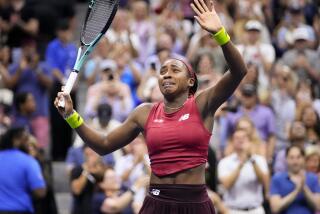Tennis : Patience Is Paying Off for Czechoslovakia’s Late Bloomers
- Share via
The 1985 U.S. Open had just been transformed into the Czechoslovakian Open, with Ivan Lendl thrashing John McEnroe to join countrywoman Hana Mandlikova on the singles victory stand.
Lendl was asked how the news of this Czech double-conquest of America would be received back in the homeland.
“Well, I don’t think they have much to complain about,” Lendl deadpanned.
For the first time since 1973, when Australians John Newcombe and Margaret Court won championships, a foreign country had swept both singles titles at the U.S. Open. Not bad for a nation smaller than most American states.
Imagine Florida winning the Davis Cup.
That would rate as the rough equivalent to the Czechs’ showing at Flushing Meadow this year. And that’s not even counting:
--Helena Sukova, Czechoslovakia’s No. 2-ranked women’s player, teaming with West Germany’s Claudia Kohde-Kilsch to upset Martina Navratilova and Pam Shriver in the women’s doubles final.
--Quarterfinalist Tomas Smid and Miloslav Mecir joining Lendl among the tournament’s 16 seeded men’s players.
--The fact that two-time defending women’s champion and 1985 runner-up Navratilova was born and raised in Czechoslovakia, only to defect to the United States in 1981.
If 1984 was the year of the Swedes in professional tennis, Czechoslovakia will at least get to share the same billing with West Germany in 1985. Sole possession of that title could be determined later this month when Lendl, Smid and Co. take on Boris Becker and the West Germans in the Davis Cup semifinals.
The Czechs have arrived. Mandlikova talked about the rise of tennis--a sport long dominated by capitalist Australia, Great Britain and the United States--in communist Czechoslovakia.
“I think (Czech tennis players) know that it’s the only sport at home that they can be free, that they can travel as much as they want,” Mandlikova said. “They can make lots of money if they play well.
“They see that Lendl is doing well, I’m doing well, Tomas Smid . . . and that lifts them. They are working harder than the others.”
And, they tend to work longer.
The United States can produce a 16-year-old champion such as Tracy Austin. West Germany has introduced two teen prodigies, Becker and Steffi Graf, this summer. But Czechoslovaks tend to mature more slowly.
First-time U.S. Open titlists Lendl and Mandlikova are 25 and 23, respectively. Navratilova didn’t win her first U.S. Open until she was one month shy of her 27th birthday.
Mandlikova has a theory about her country’s record of late tennis bloomers.
“American people grow up much faster,” she said. “They develop more mentally. In my home, your family does everything for you, and then I went out and had to be independent. It took time to realize that I had to do things on my own.
“Kids here (in the United States) do everything on their own from the beginning.” Then, mimicking a hockey player delivering a forearm check, Mandlikova added: “They have shoulders and elbows and just go like that. I think that’s a great attitude. When Americans come to France and they don’t speak French, (they still make) people understand them. I think that’s a great attitude.”
But at Flushing Meadow in 1985, the Czechs had the winning attitude. It’s called: Patience, patience, patience.
More to Read
Go beyond the scoreboard
Get the latest on L.A.'s teams in the daily Sports Report newsletter.
You may occasionally receive promotional content from the Los Angeles Times.










